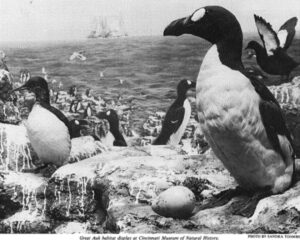Before emus, ostriches, and kiwis, there were elephant birds. These extinct, flightless birds, the largest ever to live, roamed the island of Madagascar for thousands of years. They also produced the largest eggs on record, even surpassing those of the dinosaurs.
Background
These wondrous birds made their way into the writings and imagination of Marco Polo, H.G Wells, the Thousand and One Nights, and the accounts of numerous explorers.
More research on them took place in the 19th century thanks, to French zoologist Isidore Geoffrey Saint-Hilaire. He studied three eggs, thoroughly detailed the birds’ morphology, and gave subsequent expeditions data with which to work. This prehistoric bird impressed all who saw it, mostly because of its sheer size.
Scientists say that elephant birds are an example of island gigantism, a phenomenon in which isolation on an island results in larger sizes of species. The giant tortoises of the Galapagos and the black bears of Canada’s Queen Charlotte Islands also display this gigantism.
Elephant birds are a group of extinct ratites (flightless birds) that lived predominantly in Madagascar since the Pleistocene and Holocene epochs. Its closest modern relative is the New Zealand kiwi. Scientists have documented around 13 species of elephant birds. The largest one, Vorombe titan, grew to over three meters tall and weighed over 700kg. They possessed conical beaks, stubby wings, short feathers, thick muscular legs with three toes, and an extremely long neck.

Aepyornis skeleton. Photo: Quaternary of Madagascar by Monnier, 1913
Mostly nocturnal, they lived mainly in lushly forested areas. Their diet of fruits, seeds, and leaves supposedly made them move slowly. Despite their formidable size, these herbivores did not harm the humans who settled on the island. A 2009 study found that humans had hunted elephant birds since 10,000 years ago.
Eggs
As you would guess, the size of elephant bird eggs was just as impressive. According to Guinness World Records, elephant bird eggs were the equivalent of “seven ostrich eggs, 183 chicken eggs, and 12,000 hummingbird eggs.” Elephant bird eggs could measure up to 40cm, could hold up to 11 liters of liquid, and weigh up to 8kg.
Humans living in Madagascar regularly ate these eggs. A single one could feed a very large family. Unfortunately, this contributed to the birds’ eventual disappearance. Surprisingly well-preserved, archaeologists have found the eggs, fossilized skeletons inside, and their shells all over Madagascar. The shells themselves historically served as eating bowls, tools, or for storing water.

New Zealand kiwi, the closest living relative to the elephant bird. Photo: Roberto Dani/Shutterstock
Their shells have helped archaeologists and paleontologists by preserving ancient bird DNA for study. The eggshells in Madagascar preserved DNA due to “a combination of high temperatures and alternating wet/dry cycles,” according to a 2010 study.
Extinction
Elephant birds went extinct around 1,000 years ago. Apart from human interference, the creature succumbed to climate change, the destruction of its natural habitat, and changes in the surrounding vegetation. The population steadily declined and eventually died out around 1200 AD.

Sir David Attenborough with an elephant bird egg. Photo: BBC
Collector’s item
The exoticism and rarity of elephant bird eggs have made them extremely valuable. As of now, there are over 40 eggs on display worldwide. You can find eggs at the National Geographic Society in Washington, D.C., the Buffalo Museum of Science, the Harvard Museum of National History, the Leeds Discovery Centre, and more. Private collectors have bought a few eggs at auction. In 2013, one sold for over $74,000. Sir David Attenborough has one as well, although not a complete shell.






